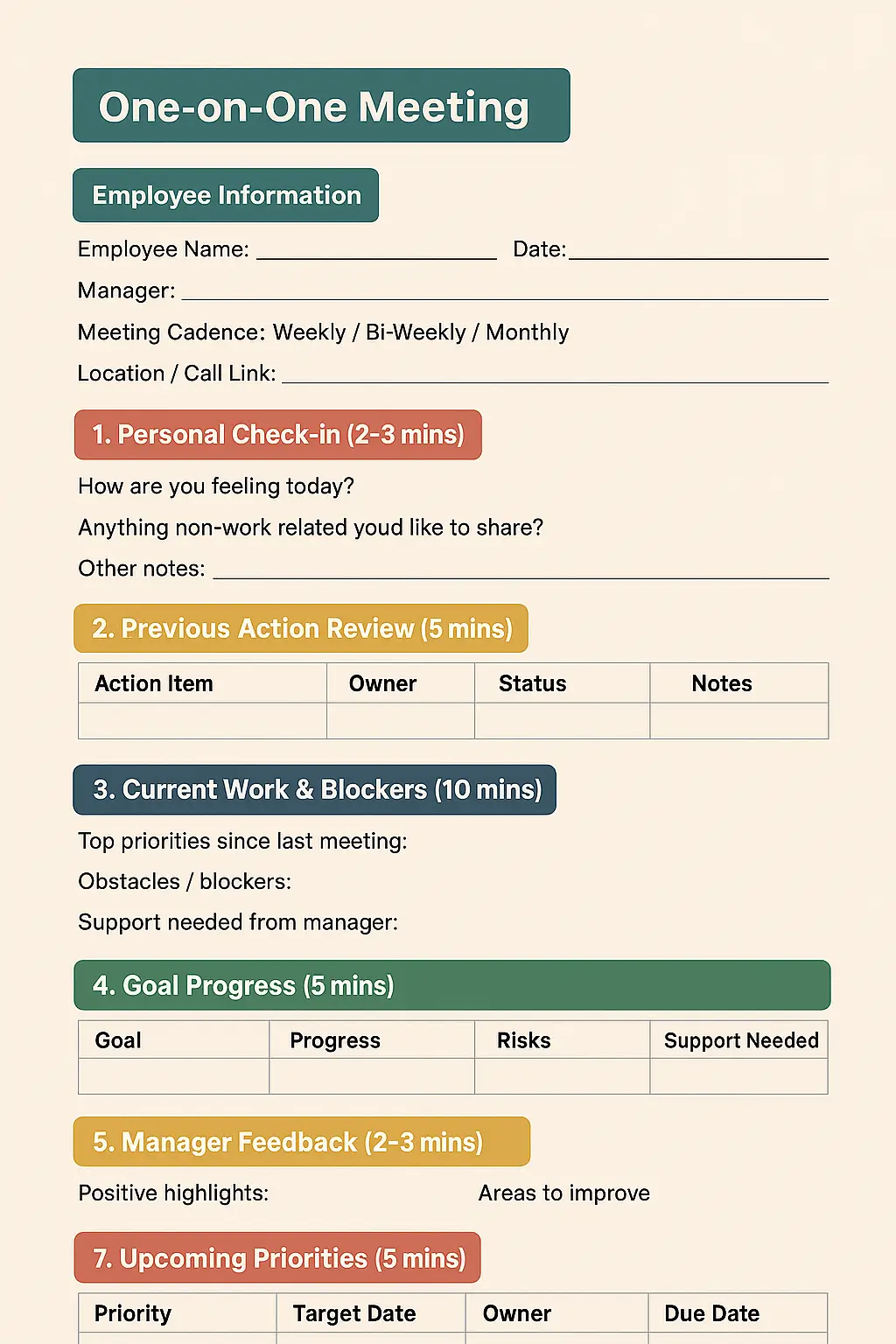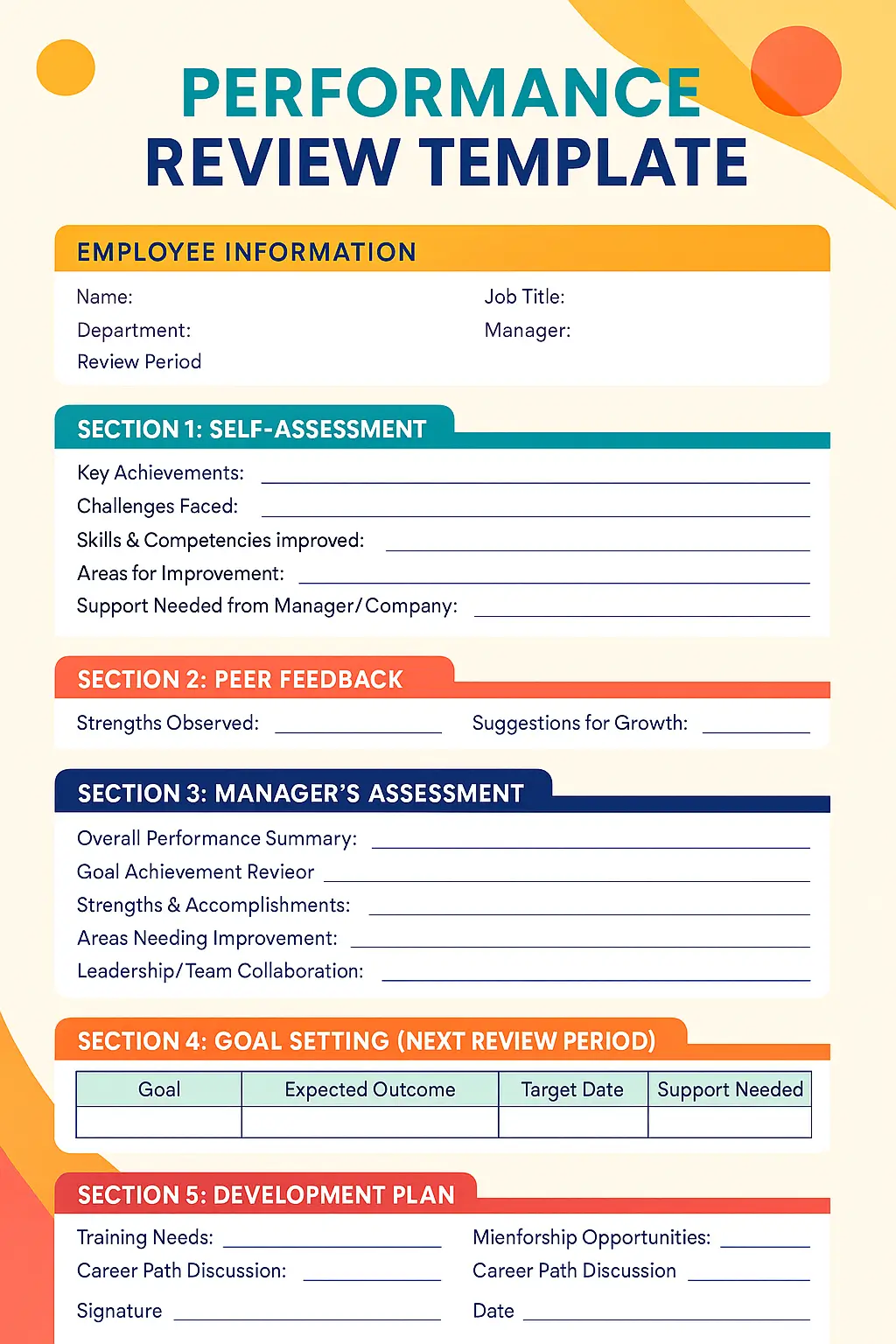One-on-One Meeting Guide: Questions, Tips & Best Practices

If you’re a manager looking to get the best out of your team, you probably know that 1:1 meetings are essential, but they’re not always easy to run. When you both come unprepared or there is inconsistent scheduling, these meetings become nothing but a waste of time.
In this comprehensive One-on-One Meeting guide, we’ll show you how to plan, prepare and how top companies run these meetings. You’ll learn what to cover, which questions to ask and what you should do to make these meetings efficient and meaningful.
What is a One-on-One Meeting?
A one-on-one meeting, also known as one-to-one or 1:1 meeting, is a regular check-in typically between a manager and an employee. Topics about performance, goals and career growth are discussed.
These meetings are not for group updates. They are to discuss the progress and challenges of an individual. Its main purpose is to improve communication and alignment. It also helps managers to understand employee needs and they can easily get clarity and share their ideas.
One-to-one meetings matter for employees, managers and the business. According to Google’s Project Oxygen research, managers who have frequent 1:1 meetings perform better than managers who do not hold them frequently. Let me share some benefits:
Benefits for Employees
Employees get clear feedback on work and performance. They can discuss career goals and development. It builds trust with their manager. They feel heard and supported.
Benefits for Managers
Managers understand workloads and priorities. They identify challenges early. They build stronger relationships with team members. They coach employees more effectively. According to Gallup, managers who provide weekly feedback rather than annual feedback help employees feel more motivated and engaged in their work.
Benefits for the Business
Businesses benefit from higher employee engagement and retention. Productivity improves because issues are resolved faster. Teams align better with company goals. Communication and culture strengthen.
See Zelt in Action
Discover how Zelt makes managing performance easy and effective.
How Top Companies Run One-On-One Meetings
Top companies treat 1:1 meetings as a system not a formality. They test approaches and track results. Let me show you how a few leaders do it.
Google encourages weekly 1:1s between managers and employees. Meetings focus on career growth and feedback. Employees help lead the agenda. Managers prioritize coaching over status updates.
Netflix
Netflix supports flexibility in 1:1s. The culture values transparency and direct conversation. Employees drive many parts of the discussion and managers give candid feedback. Meetings are honest and without scripts.
Amazon
Amazon uses data in 1:1s to guide progress. Meetings focus on goals and measurable results. Managers review metrics with employees and action items are tracked. Decisions connect to ownership and outcomes.
Microsoft and Facebook
Microsoft uses skip-level 1:1s to strengthen alignment across teams. Facebook encourages HR tools to record notes and actions. Both focus on structured follow-ups and mix performance discussions with growth planning.
Key Takeaways from Top Companies
| What to Do | Why It Works |
|---|---|
| Make 1:1s frequent and predictable | Builds trust and rhythm |
| Let employees co-own the agenda | Improves ownership |
| Keep feedback direct | Removes confusion |
| Track actions and review progress | Ensures results |
| Coach for growth | Helps long-term success |
| Follow up fast | Maintains momentum |
“The key to a good one-on-one meeting is the understanding that it is the employee’s meeting rather than the manager’s meeting. This is the free‑form meeting for all the pressing issues, brilliant ideas and chronic frustrations that do not fit neatly into status reports, email and other less personal and intimate mechanisms.”
— Ben Horowitz, co-founder at tech venture capital firm a16z, on what makes a good 1:1 meeting
How Often Should You Have 1:1 Meetings?
These meetings should happen on a schedule your team can rely on. Many top teams meet weekly. Some teams choose biweekly. Larger teams may meet monthly. Let me explain it simply.
Meeting weekly works well for fast feedback and close coaching. It suits teams that move fast or work remotely. Biweekly meetings give more time to complete action items. It fits steady workloads. Monthly meetings work when a manager supports many people. It keeps touchpoints alive without overload.
Team size and role decide the best frequency. Small teams can meet more often. Senior roles may need fewer check-ins. Early-career roles benefit from frequent coaching. High-pressure roles need more support.
If you’re unsure, start with weekly and adjust later.
Weekly vs Biweekly vs Monthly
| Frequency | Best For | Main Focus |
|---|---|---|
| Weekly | Remote teams and new hires | Feedback and coaching |
| Biweekly | Balanced workloads | Progress and clarity |
| Monthly | Large teams and senior roles | Alignment and next steps |
How to Prepare for a One-to-One Meeting
Good 1:1s start before the call begins. Preparation should be simple and clear. Here are some best steps:
- Agenda setting: Agenda setting comes first. The manager shares the meeting goal. The employee adds 2–3 points they want to discuss. The agenda stays short. Each point must solve a need or give clarity.
- Pre-meeting tips for managers: Review past notes. Check progress on action items. Think of one key area to coach.
- Pre-meeting tips for employees: Write down wins and blockers. Note one growth goal to discuss.
Preparing Notes and Tracking Progress
Keep notes short and factual. Stick to key points, decisions, and clear next steps with owners and deadlines. Only track actions that truly matter. Before the next 1:1, update progress in 30 seconds. It shows you care, builds trust and keeps momentum.
Tools and Software to Use
Choose tools that keep you both in sync without extra work. Shared docs or your HR platform’s 1:1 space work great. Use recurring calendar invites so the meeting never slips. Good HR tools (Zelt, 15Five, etc.) save notes, track actions and roll forward unfinished items automatically.
Less manual work = more time to actually talk.
What to Cover in 1:1s
The best 1:1s aren’t random chats – they drive real results. Let me walk you through the five topics that actually move the needle. Keep them short, keep them honest, and watch performance and trust grow.
Performance and Progress
Start here every time. Ask “How’s the work going?” then highlight one specific win you noticed this week. It takes 30 seconds and sets a positive tone. Quickly check if goals and expectations are still crystal clear. If something feels off, drop one quick coaching tip – nothing heavy, just helpful.
Workload and Priorities
Let me show you a question that changes everything: “On a scale of 1-10, how’s your workload feeling?” Follow up with “What are your top three priorities right now?” If things shifted, reprioritize together on the spot. Always end with “What do you need from me to hit those?”
Challenges and Roadblocks
This part saves weeks of frustration. Simply ask “What’s in your way?” Listen, name the real blocker in one sentence, then agree on the very next step to remove it. Assign a clear owner and deadline. One blocker killed per meeting keeps momentum alive.
Feedback and Recognition
Never skip this. Give one piece of specific positive feedback (“Your deck last week made the client meeting so smooth – great job simplifying the data”). Then share one piece of constructive feedback, short and kind. Flip it around: “What feedback do you have for me?” It builds trust fast.
Career Growth and Development
Even five minutes here pays off big. Ask “What’s one skill you want to grow next?” Connect it to real work coming up, then agree on one tiny step (a course, a stretch task, a mentor chat). Write it down and check progress next time. Your people will feel you’re truly invested in them.
Questions to Ask in One-on-One Meetings
Questions guide the conversation and make 1:1s productive. Let me show you which ones work best. Keep questions short and focused.
Questions for Employees
Ask about progress. Ask about challenges. Ask about career goals. Examples:
“What is going well this week?”
“What is blocking your progress?”
“Which skill do you want to grow next?”
Questions for Managers
Ask about priorities. Ask about support needed. Ask for feedback. Examples:
“Do you have enough clarity on your work?”
“Is there anything I can do to help?”
“How can I improve as your manager?”
Icebreakers / Getting-to-Know-You Questions
Start casual to build trust. Ask about motivation or work style. Examples:
“What part of your work excites you most?”
“How do you prefer to receive feedback?”
“Any wins outside of work you’d like to share?”
Types of 1-on-1 Meetings
Not all 1:1s look the same. Let me quickly show you the five main types so you always pick the right one.
First Meeting with a New Team Member
This is your golden hour. Share a bit about yourself, the team, and how you work. Set clear 30-60-90 day expectations. Ask “What are your superpowers?” and “Any early worries?” End with “I’ve got your back.” Trust starts here.
Skip-Level Meetings
The boss’s boss meets the employee directly. No filter, no fear. It uncovers blind spots fast, shows leaders care, and lets people speak freely. Keep it light, listen more than you talk.
Goal-Setting Meetings
Zero fluff. Define 2-4 bold but realistic goals. Tie them to team and company priorities. Agree on exact success metrics and deadlines. Write them down together. Done right, everyone leaves energized.
Performance Review Debriefs
Turn the formal review into a real conversation. Celebrate strengths with examples. Talk about one or two growth areas. Agree on specific next steps and support needed. Alignment feels good for both sides.
Performance Improvement Discussions
Tough but necessary. Stick to facts and patterns, stay calm and kind. Agree on 1-2 clear changes needed and exact support you’ll give. Set short check-ins. Most people step up when it’s this clear and fair.
After the Meeting: Follow-Up and Action Items
The magic happens after you close the laptop. Let me show you the three simple habits that make 1:1s actually work.
Sharing Notes: Right after the call, send a 5-bullet summary: wins, decisions, action items (who/what/when). Takes two minutes. Everyone stays on the same page and nothing gets forgotten.
Tracking Progress: Before the next meeting, glance at the actions. Update status in one click (done/on track/blocked). Seeing progress close out builds momentum and proves these meetings matter.
Planning the Next Meeting: Book the next one immediately, recurring invites are a lifesaver. Roll forward any open items automatically. Add one line about what’s top this week. Consistency like this turns good managers into great ones.
Tools, Templates, and Software for One-on-One Meetings
The right tools make 1:1s easier and more effective. Use ready-made templates to structure meetings. Include agenda, discussion points, and action items. You can download our one on one meeting template for free to save time and keep focus.
Many orgnisations also use HR software which helps them to store notes and track progress. Calendar tools keep recurring meetings on schedule and many collaboration platforms also help managers and employees to update tasks in real time.
As a tip: Keep notes digital for easy access. Record decisions and follow-ups in one place. Link tasks to next meeting agendas. This ensures nothing is forgotten and progress is clear.
Best Practices and Tips for Successful One-on-Ones
Well-run 1:1s build trust and drive results. Let me explain the key practices.
Creating a Safe Space: Ensure employees feel comfortable sharing openly. Listen without judgment. Respect confidentiality. A safe space encourages honesty and engagement.
Encouraging Two-Way Communication: Let employees lead parts of the agenda. Ask questions and get feedback. Share your perspective clearly. Two-way dialogue strengthens understanding.
Common Mistakes to Avoid
- Don’t cancel or constantly move them – it screams “you’re not priority.”
- Don’t make it all problems and no praise.
- Don’t let action items vanish into thin air.
- Skip these traps and your 1:1s stay powerful.
Tips for HR to Drive Adoption
- Train managers with short workshops and simple templates.
- Roll out easy tools and pre-built agendas.
- Put 1:1 frequency on dashboards (no shame, just visibility).
- Shout out the teams who never miss – recognition works wonders.
- A little HR nudge turns sporadic chats into company culture.
Conclusion
One-on-one meetings help managers understand their team and help employees feel supported. They keep work clear and make sure everyone knows what to do. Doing them right builds trust and makes teams stronger.
Using tools like performance management software can track goals and progress. It makes follow-ups simple and helps teams get results. Focus on preparation and action to make every meeting count.
Frequently Asked Questions
How long should a 1:1 meeting last?
1:1 should usually last 30 to 60 minutes. Keep it long enough to cover key points but short enough to stay focused. Adjust based on workload and frequency.
Can employees suggest topics?
Yes. Employees should add 1–3 topics to the agenda. This ensures their concerns are addressed. It also makes the meeting more balanced and engaging.
What to do if a 1:1 isn’t effective?
First, review the agenda and preparation. Check if feedback is clear and action items are tracked. Adjust frequency or format if needed. Encourage open dialogue and follow up consistently.


